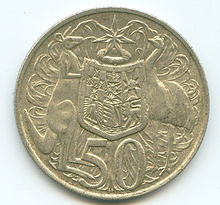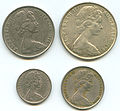- Coins of the Australian dollar
-
Coins of the Australian dollar were introduced on 14 February 1966, although they did not at that time include a one-dollar coin. The dollar was equivalent in value to 10 shillings in the former currency (half of a pound).
Contents
Regular coinage
Produced by the Royal Australian Mint, all current coins portray Queen Elizabeth II, Queen of Australia, on the obverse, with the present effigy having been designed by Ian Rank-Broadley. This is matched with designs by the Australian-born artist Stuart Devlin on the reverse. They now comprise 50c, 20c, 10c and 5c coins – all still referred to as 'silver' though actually 75% copper and 25% nickel, and for many years there were also "bronze" 2c and 1c coins.
The 50c coin originally had a circular shape, and contained 80% silver and 20% copper, so that the material of the coin was worth more than 50c. It was made to almost identical dimensional specifications as the British 2'6 pence half crown. However, to avoid confusion among the round coins, and because of its excess value, it was only produced for one year then withdrawn from circulation; there were no 50 cent coins minted for 1967 or 1968. It was changed to a 12-sided shape for 1969 and all following years, but the 12 sided issue was minted as a specimen piece in 1966-67 to test the design. It has since been issued in both standard and commemorative designs.
The standard designs on both versions of the coin are the same: the obverse carries the effigy of the sovereign, and the reverse shows the Coat of Arms of Australia. The dodecagonal version has a mass of 15.55 g and a diameter of 31.5 mm, and the round silver version has a mass of 13.28 g and diameter of 31.5 mm. 94.13 Australian 1966 round 50c coins make up a fine kilogram of silver.
Many Australians mistakenly believe that the 1966 round 50c piece is quite rare, when in fact Royal Australian Mint records indicate that some 36 million examples were struck, and 14 million were released into circulation. Nearly all the Australian round 50-cent coins from 1966 that remain in existence are now only traded for their bullion value. They are often confused with the round 50c coin from New Zealand with the date 1967-2006, which has a maritime scene on the reverse.
"Gold" two-dollar and one-dollar coins were introduced in the 1980s. The one-dollar coin was introduced in 1984, to replace the banknote of the same value. The two-dollar coin, also replacing a banknote, was introduced in 1988. These have content of 2% nickel, 6% aluminium and 92% copper. Thus, all Australian coins in use currently are composed of more than half copper. The two-dollar coin is smaller in diameter than the one-dollar coin, but the two-dollar is slightly thicker.
The one- and two-cent coins were discontinued in 1991 due to the metal exceeding face value and withdrawn from circulation.
Australian coins have medallic orientation, as do most other Commonwealth coinage, Japanese yen coinage, and euro coinage. This is in contrast to coin orientation, which is used in United States coinage.
Australian coins [1] Image Value Technical parameters Description Date of
first mintingDiameter Thickness Weight Composition Edge Obverse Reverse 
1c
(no longer used)17.53 mm 2.59 g 97% copper
2.5% zinc
0.5% tinQueen
Elizabeth IIFeathertail Glider 1966 
2c
(no longer used)21.59 mm 5.18 g Frill-necked Lizard 
5c 19.41 mm <1.3 mm 2.83 g Cupronickel
75% copper
25% nickelMilled Queen
Elizabeth IIEchidna 1966 
10c 23.60 mm <2 mm 5.65 g Superb Lyrebird 
20c 28.52 mm <2.5 mm 11.30 g Platypus 
50c Dodecagon 31.65 mm (across flats) 2 mm 15.55 g Plain Coat of arms 1969 
$1 25.00 mm <3 mm 9.00 g 92% copper
6% aluminium
2% nickelInterrupted
milledQueen
Elizabeth IIFive kangaroos 1984 
$2 20.50 mm <3.2 mm 6.60 g Aboriginal Elder 1988 These images are to scale at 0.7 pixels per millimetre. For table standards, see the banknote specification table. Commemorative coins
Main article: Australian commemorative coinsMany special versions of the 20c, 50c and $1 coins have been produced, with imagery representing an event replacing the usual design on the reverse side of the coin. For some years, all the coins are replaced with a different design for that year. In other cases, only a few coins have the new design, which are released as special commemorative coins, although many usually end up in circulation.
Collectable coins
The Royal Australian Mint regularly releases collectable coins, one of the most famous of which is the gold two hundred dollar coin. Australian collectable coins are all legal tender[2] and can be used directly as currency or converted to "normal" coinage at a bank. Metals include aluminium bronze, silver, gold and bi-metal coins (Pitt, 2000 pp. 90–100). Nugget coins are issued in ounces and fractions or kilograms and come in gold and platinum, some are denominated in dollars others only their weight value (Pitt, 2000 pp. 101–109).
See also
- List of people who have appeared on Australian currency
- Swedish rounding
References
- Krause, Chester L. and Clifford Mishler (2003). 2004 Standard Catalog of World Coins: 1901–Present. Colin R. Bruce II (senior editor) (31st ed. ed.). Krause Publications. ISBN 0873495934.
- Ian W. Pitt, ed (2000). Renniks Australian Coin and Banknote Values (19th ed. ed.). Chippendale, N.S.W.: Renniks Publications. ISBN 978-0-9585574-4-3.
External links
- Cruzi's Coins
- Guide to predecimal coins
- Australia's first coins - State Library of NSW
- Australian Decimal Currency
- Mintages from 1966-2007 from the Royal Australian Mint
- Commemorative Designs from the Royal Australian Mint
Australian currency Topics Mints Coins Banknotes Historic Australian economy History Currency State economies Industries Agriculture · Tourism · Insurance · Property market · Fishing industry · Mining · Wine · Manufacturing · Car industry · Transport · Telecommunications · Ports · SuperannuationTaxation Banking and Finance Regulatory agencies Reserve Bank · ACCC · Corporations law · AIRC · APRA · ASIC · ASX · S&P/ASX 50 · S&P/ASX 200 · Corporations powerEnergy Energy efficiency rating · Biofuel · Wind power · Geothermal power · National Electricity Market · Green electricityEconomic conditions Unions Trade agreements  Category:Economy of AustraliaCategories:
Category:Economy of AustraliaCategories:- Decimal coins of Australia
- Coins of Australia
- Currencies of Australia
Wikimedia Foundation. 2010.


